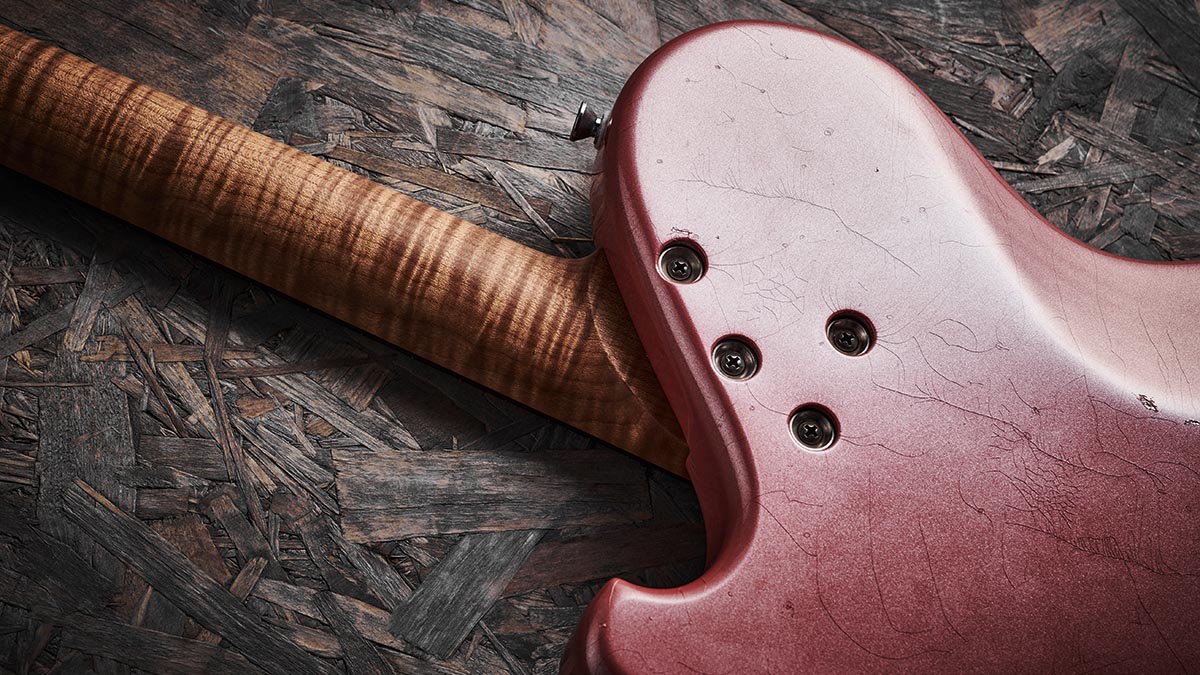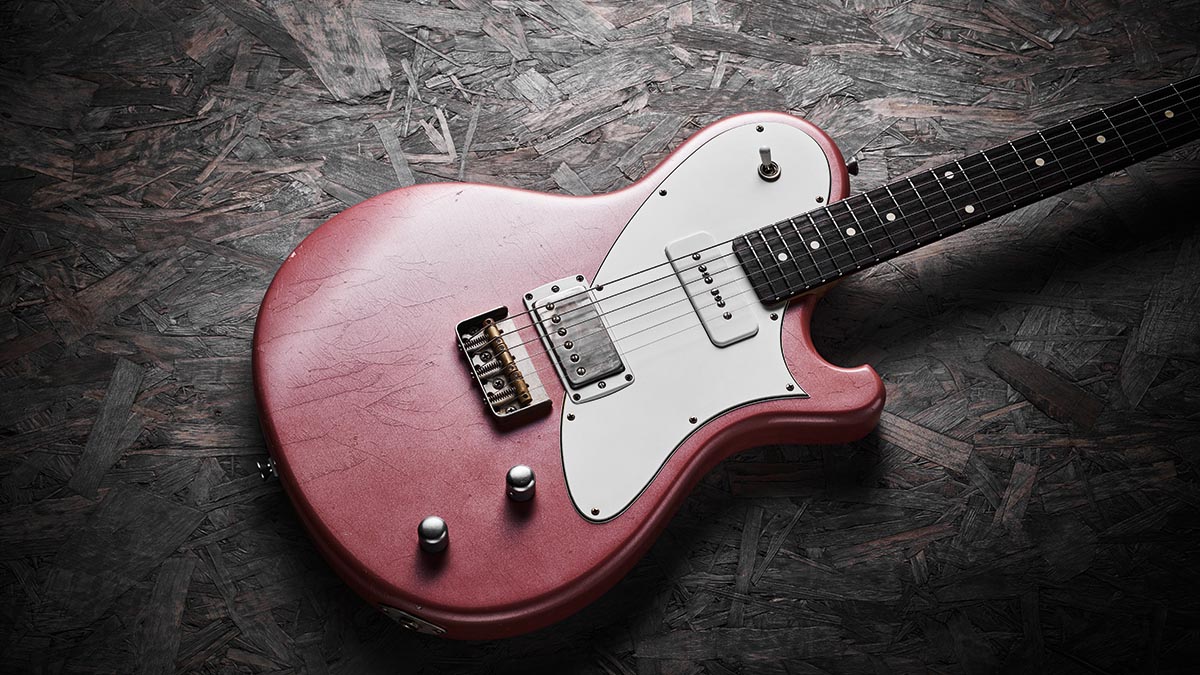Guitar World Verdict
Yes, at almost £3.5k it is getting on for Fender Custom Shop money, particularly if you were to indulge in some of the available options, but it holds its own in that company or with pretty much any top-level instrument out there. We can only imagine what the future holds.
Pros
- +
Light weight.
- +
Great neck feel.
- +
Superb pickup voicing.
- +
High-class light relicing and hardware ageing – basically, everything!
Cons
- -
Might need some tweaking to the circuit for some players, but that depends on your style.
You can trust Guitar World
With considerable experience in both retail and guitar craft, not to mention teching for numerous touring pro musicians, Seth Baccus – the step son of guitar-making legend Andy Manson – has built a considerable reputation for his Nautilus set-neck and Shoreline bolt-on custom builds.
But as Seth’s reputation escalated so did the demand, and before long he was turning down orders.
As we discuss with Seth in our feature following this review, salvation came from the newly formed York-based UK Guitar Builders (UKGB), and the electric guitar we have here is one of the first off the small production line.
To be honest, when we first heard about this collaboration, we expected to see a more cost-effective version of the £3k-plus bespoke Shoreline (there are no plans at the moment to produce the Nautilus). This guitar is anything but.
Like the Nautilus, the Shoreline uses the same original outline inspired by an acoustic guitar Andy Manson had made. Both guitars also use a Fender-like 648mm (25.5-inch) scale length (although Seth does offer a shorter scale on the Nautilus Junior in his bespoke range).

In the new range, the Shoreline comes in two styles, the original T, and the JM we have here, plus an S model that’s planned for production later in the year. Mind you, there’s very little ‘Jazzmaster’ about it…
“The ‘JM’ did in fact come from the first one I built,” Seth tells us, “and that had full-size Jazzmaster-style pickups and a Mastery vibrato. But it then evolved into various pickup configurations and bridge options. So, now the JM moniker signifies the styling and pickguard shape more than actually relating to a Jazzmaster in any specific way. Model names get more complicated over the years as things evolve and shift and change!”
All the latest guitar news, interviews, lessons, reviews, deals and more, direct to your inbox!
The JM is available, for example, with twin humbuckers or like our review model with a bridge humbucker and P-90 at the neck.

While the Shoreline’s style obviously references the classics, it’s not just the original-outline shape that’s different. Instead of alder or lightweight ash, the body here is obeche (FSC-certified), which is completely hidden by the delicious aged and lightly reliced vintage nitro finish.
It’s beautifully shaped with a large edge radius and Fender-like comfort contours on the face and back, and a pretty regular bolt-on depth of 44.5mm. The Fender-like squared heel is replaced here with the sloping line from that rounded bass shoulder to the small horn, and we have four regular machine screws that sit in steel ferrules in order to hold neck to body.
The ageing is not just to the body and headstock face finish; the hardware looks like it’s been in place for decades, too. The short Tele-bridge plate holds three intonated Gotoh ‘In-Tune’ brass saddles, and although it’s through-strung you can top-load it as well. Tuners are standard Gotoh vintage style. The beautifully shaped and cut nut appears to be unbleached bone.

Moving from open-ended custom to small production invariably limits the options, but we were surprised at what’s on offer here (see spec over the page), not least the choice of finishes.
And while you can spec your favourite-brand pickups, as standard Seth has selected a pair from his local winder Bare Knuckle: a classic Mule at the bridge mounted in an Anomaly pickup ring (developed by Seth and designer Luke White), and a Blue Note 90 at the neck that mounts directly to the body.
The drive is simple, too, with a shoulder-placed toggle pickup selector, master volume and tone with a pull-switch to split the humbucker.

Feel & Sounds
If the vintage-informed craft is beautiful, the neck is off-the-scale good. Quite what the optional ‘master grade’ neck blank would look like we don’t know, but the wood choice here is exceptional with a deep dark golden hue and broad striping. In this super-smooth oil and wax finish, rather like the guitar’s appearance, it feels old and worn in, adding to the vivid illusion that this isn’t a new guitar.
The medium jumbo frets are not only beautifully installed with smooth domed ends, they aren’t over-high, either, and really suit the guitar
There’s plenty of meat, too. It feels very robust with a deep rounded C profile that feels deeper than the dimensions suggest: 21.7mm at the 1st fret, 23.8mm by the 12th. There’s an old Fender feel at play, for sure. The nut width (42.14mm with a string spacing of 35mm) is a little narrower than the Nautilus Classic we reviewed back in issue 449, but the 305mm (12-inch) fingerboard radius is more Gibson-like.
The medium jumbo frets are not only beautifully installed with smooth domed ends, they aren’t over-high, either (approximately 2.45mm by 1.2mm), and really suit the guitar. It feels superb and the detail is everywhere, not least in the lightly rolled fingerboard edges. Excellent craft.
Thanks to the obeche body, it weighs in at 3.1kg (6.84lb), and strapped on it just feels like a part of you. But light in weight doesn’t mean light in sound. Even unplugged there’s quite a strong, full response, and as we turn up the volume we hear a really quite muscular tone emerging.

The Bare Knuckle P-90 isn’t one we can remember hearing before, but it’s certainly on our radar now. On this platform it’s smooth but with a grainy texture and cleans up nicely with volume reduction, adding a very Gibson-like voice for jazzier lines and wailing beautifully smoothly with some classic-rock crunch.
Hit the toggle to bridge and the voice is big and beefy – that muscular tone we referred to earlier. Here, the Mule sounds a little darker with quite a kick in the snarly midrange.
It’s great for grungier, rockier sounds, but backing off the volume rounds it a little more, and you can’t help thinking a sympathetic treble bleed on the volume pot would just clean things up a little more. The split voices the slug coil and might be a bit too much of a contrast on its own, but in the pickup mix it certainly works to add more Fender-y character.
Verdict
Having previously played and reviewed both a solo-built Nautilus Classic and Shoreline S, this new small production model frankly appears little different in terms of specification and superb craft.
The clever amalgamation of classic construction and pickup styles blurs the lines between ‘Fender’ and ‘Gibson’, and it’s not just the lightly reliced finish and aged hardware that make you think this is a pre-owned piece; it really feels like one, too, not least the neck. Yet from the moment we opened the Hiscox case there’s nothing precious or “Don’t touch me!” about this piece: it’s made to be played.
Yes, at almost £3.5k it is getting on for Fender Custom Shop money, particularly if you were to indulge in some of the available options, but it holds its own in that company or with pretty much any top-level instrument out there. We can only imagine what the future holds.
Specs

- PRICE: £3,399 (inc case)
- ORIGIN: UK
- TYPE: Single-cutaway, solidbody electric
- BODY: Obeche
- NECK: Quarter-sawn roasted flame maple, medium C profile, bolt-on
- SCALE LENGTH: 648mm (25.5”)
- NUT/WIDTH: Bone/42.14mm
- FINGERBOARD: Indian rosewood, ‘clay’ dot inlays, 305mm (12”) radius
- FRETS: 22, medium jumbo (Jescar)
- HARDWARE: Gotoh bridge with ‘In-Tune’ brass saddles and through-body stringing, vintage-style split-post tuners – aged nickel-plated
- STRING SPACING, BRIDGE: 54mm
- ELECTRICS: Bare Knuckle Mule (bridge) humbucker and Blue Note 90 (neck) single coil, 3-way toggle pickup selector, master volume and tone (with pull switch to split bridge humbucker)
- WEIGHT (kg/lb): 3.11/6.84
- OPTIONS: Maple fingerboard (n/c), Master grade flame neck (£400), semi-hollow with f-hole (£400), double-bound body (£400), Mastery vibrato (£500) plus a variety of custom finishes and scratchplates and alternative brands of pickups on request
- RANGE OPTIONS: Shoreline T with four-way switching (£3,199), the double-humbucking Shoreline JM HH (£3,499)
- LEFT-HANDERS: Planned for 2023
- FINISHES: Burgundy Mist (as reviewed) from 12 solid colour options plus 2 translucent colours – aged gloss nitro to body and headstock face; oil and wax to neck
- CONTACT: Seth Baccus

Dave Burrluck is one of the world’s most experienced guitar journalists, who started writing back in the '80s for International Musician and Recording World, co-founded The Guitar Magazine and has been the Gear Reviews Editor of Guitarist magazine for the past two decades. Along the way, Dave has been the sole author of The PRS Guitar Book and The Player's Guide to Guitar Maintenance as well as contributing to numerous other books on the electric guitar. Dave is an active gigging and recording musician and still finds time to make, repair and mod guitars, not least for Guitarist’s The Mod Squad.

